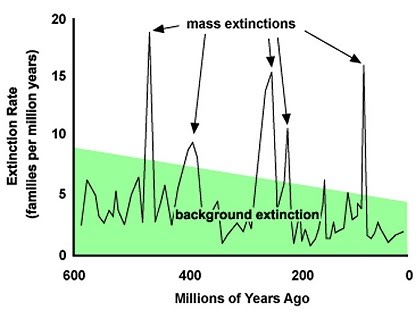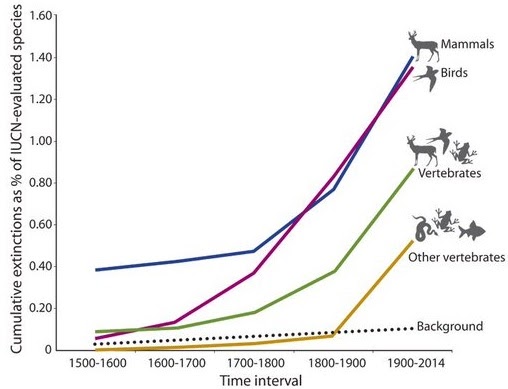Mass extinction and biodiversity
Mass extinction
Measuring biodiversity
Mass extinction
Extinction events are defined by periods of great loss of biodiversity. Fossil evidence has pointed to several mass extinctions from multiple causes including the great oxygenation event following the evolution of plant photosynthesis, environmental effects caused by forces outside the Earth, and indeed the expansion of human populations.
Depending on the data used and the thresholds set for what is considered a mass extinction, at least five and as many as a couple dozen extinctions events have been identified over the course of life on Earth (more than 4 billion years). Extinctions focus on multicellular life because it is readily observable compared to microbial life. The latter, however, accounts for most of the biodiversity on Earth. In addition to this, since the fossil record relies on fossilisation, it represents those specimens that are readily able to fossilise.

A theme of change in biodiversity surrounding extinction events is the opportunity provided by the extinction to displace the dominant species of large land animals, for example, and provide space for new species to take over. Ancient species resembling present crocodiles and birds (archosaurs) dominated the land before the Triassic-Jurassic extinction event which culled many of them, leaving space for dinosaurs to take over. Dinosaurs then went entirely extinct, bar for avian ones, during the next extinction event (Cretaceous-Paleogene), enabling the small land mammals to spread further and diversify.
Following each extinction, the few remainder species continued speciating out, regaining biodiversity over time. The extinction of species arising slowly over time as a reflection of changing environments is the background rate of extinction, and stands at a few taxonomic families of marine animals every million years. Extinction events far exceed the background rate of extinction in a short amount of time.
Human expansion has caused an uptick in the extinction rate of plants and animals, possibly initiating another extinction event. The extinction rate has recently increased by a factor of 1,000 up to 10,000.

There are difficulties with estimating current and past extinction rates. Models for working rates out have produced estimates that do not match up with the fossil record. When models are based on specific traits in a species, and attempt to show the potential for that species diversifying, they produce results that exceed what is actually possible…


